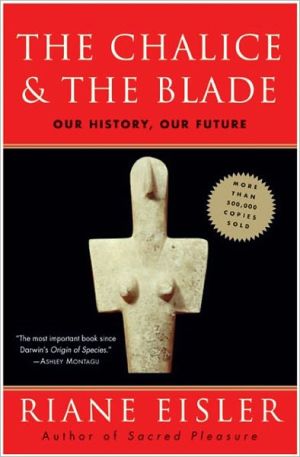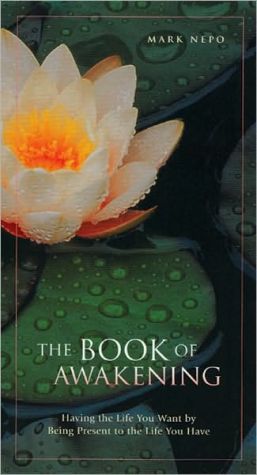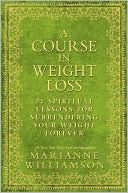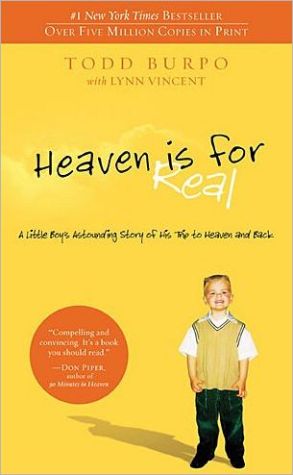Chalice and the Blade: Our History, Our Future
The legacy ofthe sacred feminine\ The Chalice and the Blade tells a new story of our cultural origins. It showsthat warfare and the war of the sexes are neither divinely nor biologicallyordained. It provides verification that a better future is possible—and is in factfirmly rooted in the haunting dramas of what happened in our past.\ \ \ Bringing together recent discoveries in archaeology with evidence from art, religion, anthropology, sociology, politics, and...
Search in google:
The phenomenal bestseller, with more than 500,000 copies sold worldwide, now with a new epilogue from the author—The Chalice and the Blade has inspired a generation of women and men to envision a truly egalitarian society by exploring the legacy of the peaceful, goddess-worshipping cultures from our prehistoric past. San Francisco Chronicle Book Review Validates a belief in humanity's capacity for benevolence and cooperation in the face of so much destruction.
Chapter One\ \ Journey into a Lost World:\ The Beginnings of\ Civilization\ \ \ \ Preserved in a cave sanctuary for over twenty thousand years, a female figure speaks to us about the minds of our early Western ancestors. She is small and carved out of stone: one of the so-called Venus figurines found all over prehistoric Europe.\ Unearthed in excavations over a wide geographical area—from the Balkans in eastern Europe to Lake Baikal in Siberia, all the way west to Willendorf near Vienna and the Grotte du Pappe in France—these figurines have been described by some scholars as expressions of male eroticism: that is, an ancient analogue for today's Playboy magazine. To other scholars they are only something used in primitive, and presumably obscene, fertility rites.\ But what is the actual significance of these ancient sculptures? Can they really be dismissed as the "products of unregenerated male imagination"?1 Is the term Venus even appropriate to describe these broad-hipped, sometimes pregnant, highly stylized, and often faceless figures? Or do these prehistoric sculptures tell us something important about ourselves, about how both women and men once venerated the life-giving powers of the universe?\ The Paleolithic\ Along with their wall paintings, cave sanctuaries, and burial sites, the female figurines of the peoples of the Paleolithic are important psychic records. They attest to our forebears' awe at both the mystery of life and the mystery of. death. They indicate that very early in human history the human will to live found expression andreassurance through a variety of rituals and myths that seem to have been associated with the still widely held belief that the dead can return to life through rebirth.\ "In a great cavern sanctuary like Les Trois Frères, Niaux, Font de Gaume or Lascaux," writes the religious historian E. O. James, "the ceremonies must have involved an organized attempt on the part of the community . . . to control natural forces and processes by supernatural means directed to the common good. The sacred tradition, be it in relation to the food supply, the mystery of birth and propagation, or of death, arose and functioned, it would appear, in response to the will to live here and hereafter."2\ This sacred tradition found expression in the remarkable art of the Paleolithic. And an integral component of this sacred tradition was the association of the powers that govern life and death with woman.\ We can see this association of the feminine with the power to give life in Paleolithic burials. For example, in the rock shelter known as Cro-Magnon in Les Eyzies, France (where in 1868 the first skeletal remains of our Upper Paleolithic ancestors were found), around and on the corpses were carefully arranged cowrie shells. These shells, shaped in the form of what James discreetly calls "the portal through which a child enters the world," seem to have been associated with some kind of early worship of a female deity. As he writes, the cowrie was a lifegiving agent. So also was red ocher, still in later traditions the surrogate of the life-giving or menstrual blood of woman.3\ The main emphasis seems to have been on the association of woman with the giving and sustaining of life. But at the same time, death—or, more specifically, resurrection—also appears to have been a central religious theme. Both the ritualized placement of the vagina-shaped cowrie shells around and on the dead and the practice of coating these shells and/or the dead with red ocher pigment (symbolizing the vitalizing power of blood) appear to have been part of funerary rites intended to bring the deceased back through rebirth. Even more specifically, as James notes, they "point to mortuary rituals in the nature of a life-giving ritual closely connected with the female figurines and other symbols of the Goddess cult."4\ In addition to this archaeological evidence of Paleolithic funerary rites, there is also evidence of rites seemingly designed to encourage the fecundity of the wild animals and plants that provided our forebears with life support. For example, in the gallery of the inaccessible cavern of Tuc d'Audoubert in Ariège, on the soft clay floor underneath the wall painting of two bisons (a female followed by a male), we find impressions of human feet believed by scholars to have been made in ritual dances. Similarly, in the Cogul rock shelter in Catalonia, we find a scene of women, possibly priestesses, dancing around a smaller naked male figure in what seems to be a religious ceremony.\ These cave sanctuaries, figurines, burials, and rites all seem to have been related to a belief that the same source from which human life springs is also the source of all vegetable and animal life—the great Mother Goddess or Giver of All we still find in later periods of Western civilization. They also suggest that our early ancestors recognized that we and our natural environment are integrally linked parts of the great mystery of life and death and that all nature must therefore be treated with respect. This consciousness—later emphasized in Goddess figurines either surrounded by natural symbols such as animals, water, and trees or themselves partly animal—evidently was central to our lost psychic heritage. Also central to that lost heritage is the apparent awe and wonder at the great miracle of our human condition: the miracle of birth incarnated in woman's body. Judging from these early psychic records, this was a central theme of prehistoric Western systems of belief.\ Now what we have been developing to this point is still not the view of many scholars. Nor is it the view still taught in most survey classes about the origins of civilization. For here, as in most popularized writings on the subject, there still prevail the preconceptions of earlier scholars who saw Paleolithic art in terms of the conventional stereotype of "primitive man": bloodthirsty, warlike hunters, in fact very unlike some of the most primitive gathering-hunting societies discovered in modern times.5
\ Chicago Tribune“Everyone…should have the opportunity to read it.”\ \ \ \ \ LA Weekly“The Chalice and the Blade may be the most significant work published in all our lifetimes.”\ \ \ San Francisco Chronicle“Validates a belief in humanity’s capacity for benevolence and cooperation in the face of so much destruction.”\ \ \ \ \ Isabel Allende“Some books are like revelations, they open the spirit to unimaginable possibilities. The Chalice and the Blade is one of those magnificent key books that can transform us and… initiate fundamental changes in the world.”\ \ \ \ \ Ashley Montagu“The most important book since Darwin’s Origin of Species .”\ \ \ \ \ Ashley MontaguThe most important book since Darwin's Origin of Species.\ \ \ \ \ Isabel AllendeSome books are like revelations, they open the spirit to unimaginable possibilities. The Chalice and the Blade is one of those magnificent key books that can transform us and . . . initiate fundamental changes in the world. With the most passionate eloquence, Riane Eisler proves that the dream of peace is not an impossible utopia.\ \ \ \ \ Bruce WilshireAs important, perhaps more important, than the unearthing of Troy or the deciphering of cuneiform.\ \ \ \ \ Jessie BernardA gem . . . A rare combination of poetic expression and sober substance.\ \ \ \ \ LA WeeklyThe Chalice and the Blade may be the most significant work published in all our lifetimes.\ \ \ \ \ Chicago TribuneEveryone . . . should have the opportunity to read it.\ \ \ \ \ San Francisco Chronicle Book ReviewValidates a belief in humanity's capacity for benevolence and cooperation in the face of so much destruction.\ \ \ \ \ New Age JournalThe greatest murder mystery and cover-up of all time.\ \ \ \ \ From Barnes & NobleExamining the age-old phenomenon of human cruelty and our propensity towards war, and weaving together evidence from art, archaeology, religion, social science, history, & other fields of inquiry into fresh patterns, the author tells a new story of our cultural origins. Eisler shows us that neither armed conflict nor the "war of the sexes" are divinely or biologically ordained, verifying that a better future is possible and is firmly rooted in the haunting drama of what actually happened in our past. "An ambitious new synthesis..."-- Los Angeles Times.\ \








